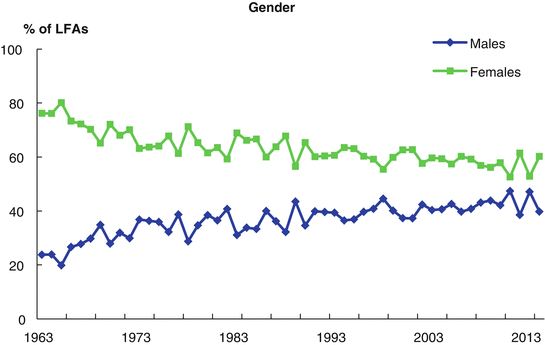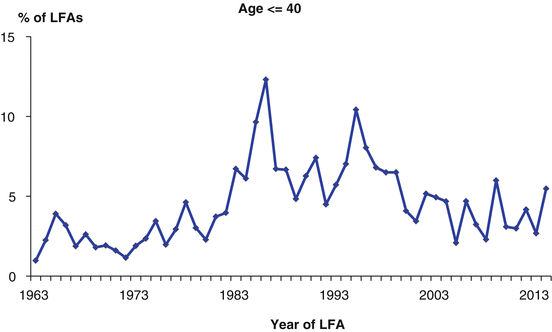, Paul D. Siney1 and Patricia A. Fleming1
(1)
The John Charnley Research Institute Wrightington Hospital, Wigan, Lancashire, UK
Charnley low-frictional torque arthroplasty (LFA) continues to be an evolutionary procedure. Changes in the design materials and surgical technique are introduced as a result of information gathered from long-term follow-up clinical studies, management of complications, findings at revision surgery or examination of explanted components. These changes, modifications and improvements can be seen as being within the control of the individual implementing them, but what about the changes that are independent of that control? Is there a changing pattern of patients presenting for surgery, which may, in the long-term affect the outcome? We reviewed our database in order to establish if there is a discernable changing pattern in patients presenting for surgery.
We have examined the information, collected prospectively, on patients undergoing primary Charnley LFA between November 1962 and December 2014. Included are only those cases where the design, materials and surgical technique conformed with the Charnley concept as practised at that particular stage of the evolution of the operation.
During the 52 year period: 1962–2014, 25,752 primary LFAs, have been carried out. The changing patterns are presented graphically with percentages being part of the whole group.
Gender
There is a gradual increase in the number of male patients being accepted for the operation: from the initial 20 % to about 40 % (Fig. 43.1).


Fig. 43.1
Changing patterns of patients. Graph showing gradual increase in males presenting for hip replacement
Age
Since with growing experience younger patients were accepted for the operation, we have taken age 40 years as a dividing level comparing patients aged 40 years or younger with those over 40 years of age. There were 992 patients (3.85 %) aged 40 years or younger at the time of the LFA, the numbers gradually increasing from the early 1970s onwards (Fig. 43.2).


Fig. 43.2
Changing patterns of patients. Younger patients being accepted for hip replacement
Underlying hip pathology
Stay updated, free articles. Join our Telegram channel

Full access? Get Clinical Tree








